Overclocked: Our Custom Radeon HD 5870 Roundup
by Ryan Smith on May 19, 2010 11:53 AM ESTOverclocked Performance
Now that we’ve settled the matter of how overclockable our cards are, let’s take a look at their overclocked performance. For these benchmarks our cards are clocked at the following:
Sapphire Toxic 2GB: 900/1250
MSI Lighting: 940/1300
Gigabyte Super Overclock: 950/1325
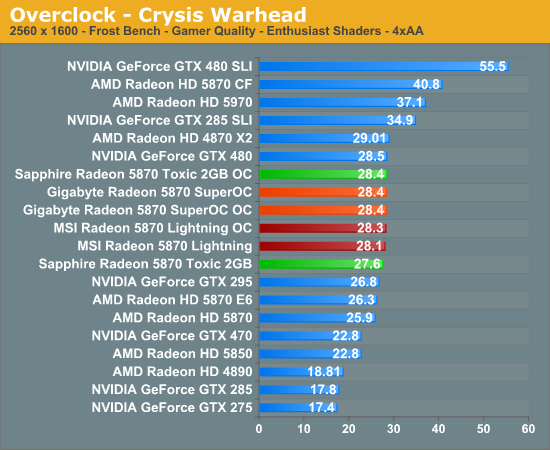
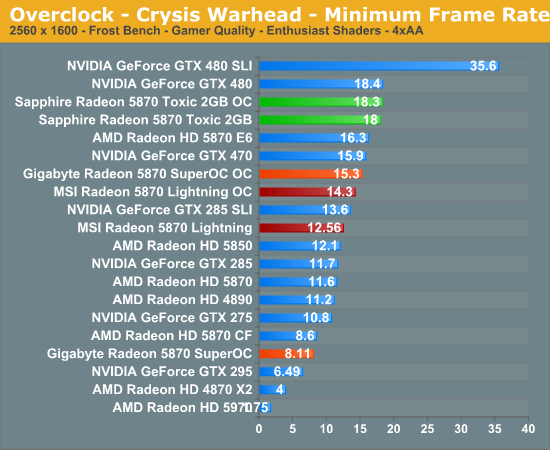
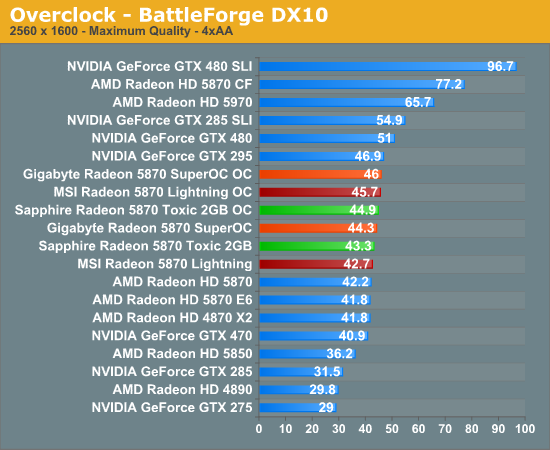


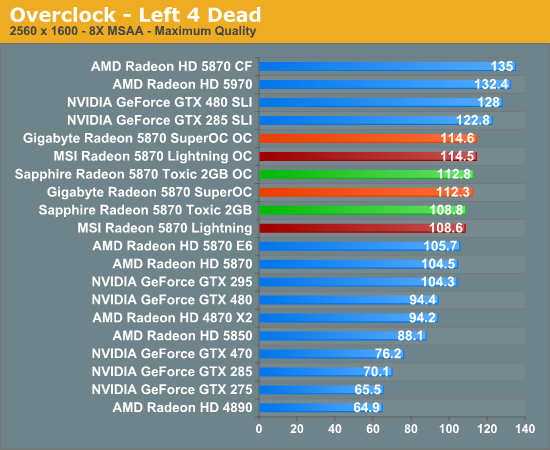
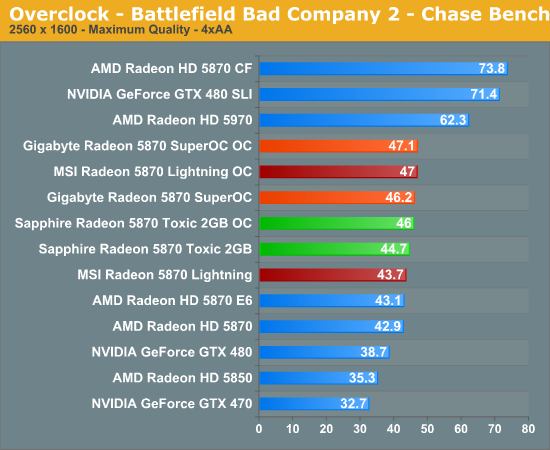
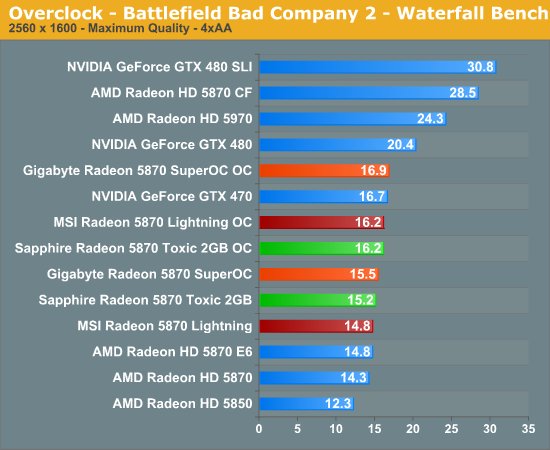
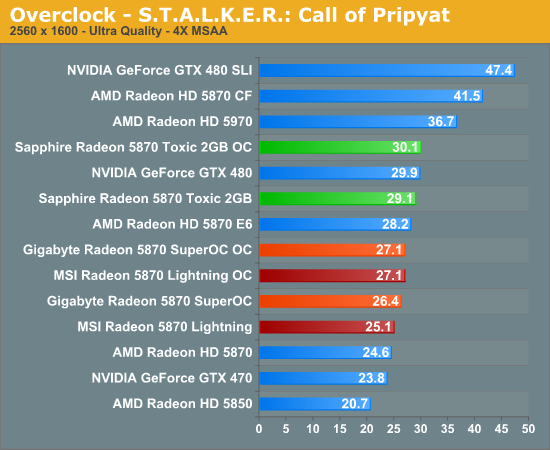
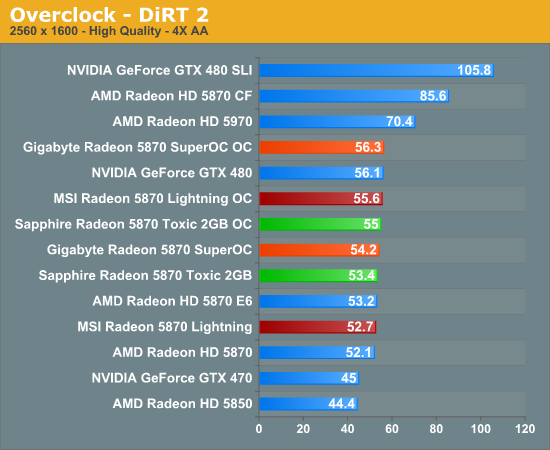
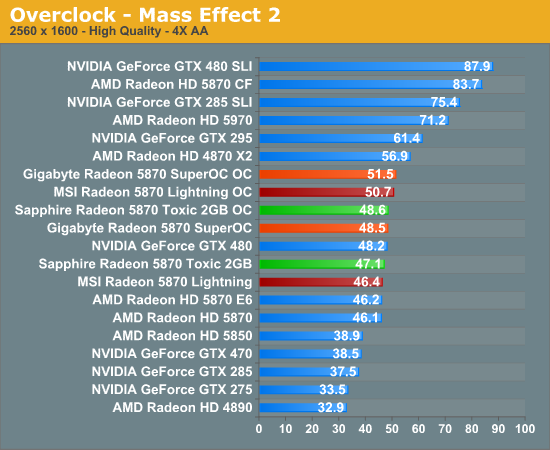
With our slight overclocks in place, we pick up between 4% in performance for the Sapphire and Gigabyte cards to 7% for the MSI card. More often than not the Gigabyte card still edges out the Sapphire card thanks to the former’s greater memory overclock, but of course the Sapphire still wins in all situations where 2GB of RAM provides a tangible benefit.
Overall their overclocks are all close enough to each other that the performance difference is splitting peanuts – the difference comes out to fractions of a frame per second much of the time. So there’s a clear winner in the Gigabyte card when going by the numbers, but the MSI and Sapphire cards are not appreciably slower.
All told, overclocking has improved the performance of these cards to between 9% and 10% over a reference 5870. 10% more on a 5870 is a fairly important number, and we’ll get in to that more at the end of this review.










43 Comments
View All Comments
KayDat - Wednesday, May 19, 2010 - link
An interesting result...but looking at some other 5870 reviews, OC3D reviewed an XFX 5870 xXx edition ( http://www.overclock3d.net/reviews/gpu_displays/xf... ), which is an OC oriented card based off reference design, and they managed to get a 984MHz overclock, along with the cards stock 1300MHz memory. Would be interesting if you could take a look at that card as well.Nimiz99 - Wednesday, May 19, 2010 - link
on the page for overall OC results it readsSapphire Toxic 2GB: 600/1250
MSI Lighting: 940/1300
Gigabyte Super Overclock: 950/1325
i think the saphire should be 960
---
BTW, thank you for giving us a quick overview of the OC advantage over stock speeds. It's something I am always interested in to see if paying for the OC ability is worth it.
Great article
Earthmonger - Wednesday, May 19, 2010 - link
I was really hoping these OCs would conquer the stock GTX 480. I've been looking for a reason to NOT go nVidia this round. As a water cooler, noise and heat are irrelevant to me. Power is my only concern. 170w vs 190w at idle, and within 50w at load (Crysis)... I'm not sure that small of a difference is enough justification to buy a slower GPU.PS, in the test setup you list the NVIDIA GeForce GTX 260 Core 216, but have no results for it in any of the tests. Typo?
MadMan007 - Wednesday, May 19, 2010 - link
It looks to me like the power draw penalty for 2GB on the Sapphire card is ~25W. Is there something else like clock speeds that are somehow being factored in or was this just a mistake?BlendMe - Wednesday, May 19, 2010 - link
That's a 92mm not cm fan on the sapphire.Rick83 - Wednesday, May 19, 2010 - link
and 80 mm (again, not cm) on the MSI...BlendMe - Wednesday, May 19, 2010 - link
and on the Gigabyte as well...Ryan Smith - Wednesday, May 19, 2010 - link
If I'm going to be wrong, at least I'm going to be consistently wrong.marc1000 - Thursday, May 20, 2010 - link
LOL!!!!!every now and then, there is some joke here that makes me laugh... good article btw!
about the overcloks, it looks like a future re-spin of the cypress running at 1ghz could overcome the Fermi.... it would be fun to see a 2 billion transistor GPU running faster than a 3 billion one....
Voo - Thursday, May 20, 2010 - link
The thing is compared to Cypress Fermi overclocks exceptionally well, especially considering the fact that when it first appeared I don't think anyone thought it would. Seems like Fermi should profit a lot more from a die shrink than cypress, but let's see what NI brings to the table.